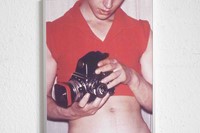As his new exhibition opens at Soft Opening in London, we give you a five-point guide to the erotically charged, subculture-obsessed work of American artist Dean Sameshima
The art of Dean Sameshima defies classification. Working across a variety of forms including photography, collage and found images, the American-born artist has created a body of work that plumbs the depths of subcultures and queer identity, exploring ideas of eroticism, history, and the relationship between art and its viewer.
Ahead of the opening of being alone, a solo show of photographs that zero in on a solitary viewer in a Berlin porn theatre, at Soft Opening in London, and an exhibition of his work at the 2024 Venice Biennale, Sameshima’s work – and the ways in which it deftly cruises through both historical archives and contemporary technologies – is as gripping and seductive as its ever been.
Below, we give you a five-point guide to the erotically charged work of Dean Sameshima.
1. Sameshima has a thing for erotic locations
At the heart of Sameshima’s new solo show, being alone, is a Berlin pornographic film theatre. The stark, high contrast of his photographs renders the screen almost blindingly bright, as the onlooker projects their fantasies onto it. It’s through images like this that Sameshima explores not only the aesthetics of erotic spaces, but the meanings we give them; being alone creates not only a space for fantasy, but one of safety.
In his series Erdbeermund (2023), photos of glory holes turn from erotic sites to a kind of hypnotic looking glass, with Sameshima offering a glimpse into fading, secret worlds. Sameshima says that his aim here is to explore “scenes that were often overlooked in everyday life […] presenting spaces that are highly charged, but without being explicit.”

2. He’s an archivist of queer and lost subcultures
Sameshima is, however, explicit in the relationship that his practice has with queer spaces and subcultures, saying “I’ve always had an impulse to document and save, or archive, out of fear of these things disappearing.” This impulse can be felt in a new series of work, titled Traces – on display as part of the group exhibition Scratching at the Moon at the ICA in LA – which includes photographs of places from the 1990s up until today, capturing how places change with time, creating what Sameshima calls “a tension regarding time and history.”
In a series about the queer outlaws of the past, Sameshima’s City Men (2015) makes a direct reference to experimental/pornographic filmmaker Fred Halsted, who Sameshima says is still a figure existing on the fringes, hoping that work like City Men can “make sure those names aren’t forgotten.”

3. He takes pornography seriously
As his reference to Halsted makes clear, Sameshima is an artist with a deep interest in the form and history of pornography. His collage series If there’s a heaven above (Rooster Fish Bathroom) from 2001-16, presents wild fragments of male bodies in eroticised, sexually explicit positions and poses. The deeply analogue vibe of these images – like stills ripped from a magazine – echoes Sameshima’s statement that his “interest in erotica and desire and porn go hand in hand with the evolution of technology.”
The artist makes reference to a series of images from 2000, inspired by the dawn of gay online dating. This series, Figures of Lust Furtively Encountered in the Nights, taken from these websites, captures how queer bodies began to exist in cyberspace, even as their relationship to flesh and blood places has changed with time. As Sameshima says, “part of being alone is acknowledging the decline of porn theatres around the world, which is a product of current technological advances.”

4. He’s interested in the relationship between image and spectator
The photographs in being alone have a tension to them; an uncertainty of what exactly it is we’re supposed to be looking at. Is it the anonymous figure, feet up, staring at a vast screen, or is it the screen itself? The blankness of the movie theatre screen invites a viewer to project their own fantasies there, just as much as Sameshima’s subject might be doing. The same is true of Erdbeermund, in which a glory hole becomes a kind of perverse looking glass, the viewer looking both at and through the image simultaneously.
With a practice that explores eroticism in such depth, this dynamic seems to invite viewers to consider what it is about these spaces we imbue with meaning, and the relationship they might have to our own fantasy lives. As the artist himself says: “I hope all my work is seductive and informative.”

5. His art is always evolving
One of the things that makes Sameshima’s work so compelling is his refusal to fall into a single formal box. The photographs of being alone are so formally different from his “documentary paintings” in his 647(a) series, and yet they share a common ground; a desire to understand not just in capturing the things that we remember, but also capturing things we might forget. Sameshima admits to struggling with “artistic monogamy” early in his career, although now he’s more than willing to admit that “not every idea can be expressed through photography.”
The evolution of Sameshima’s work is rooted in the importance of preserving history and knowledge. He’s forthright about this, saying that coming of age in the 80s was “an important time and a very scary time for a young gay man.” While his work celebrates what couldn’t be celebrated during his youth, it also serves to acknowledge what he calls the “fear and repression [that] still exists for many people around the world.”
being alone by Dean Sameshima is on show at Soft Opening in London until 8 June 2024.






